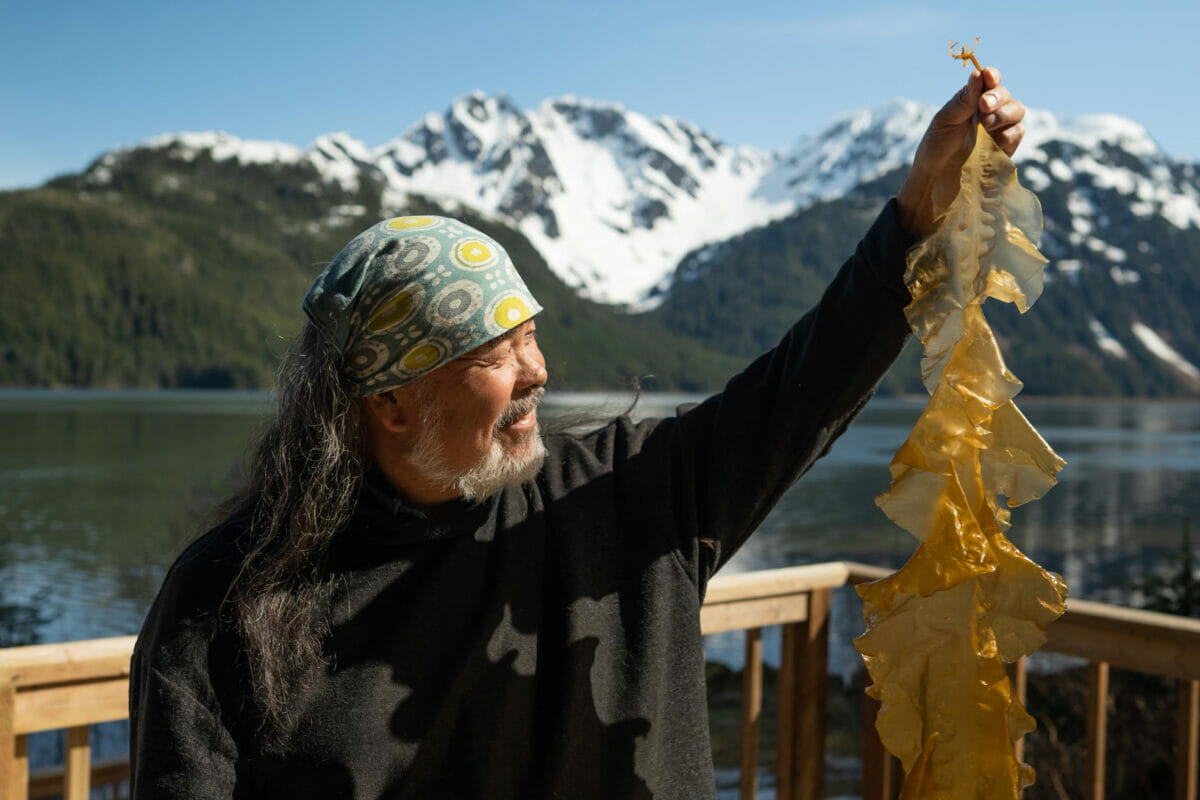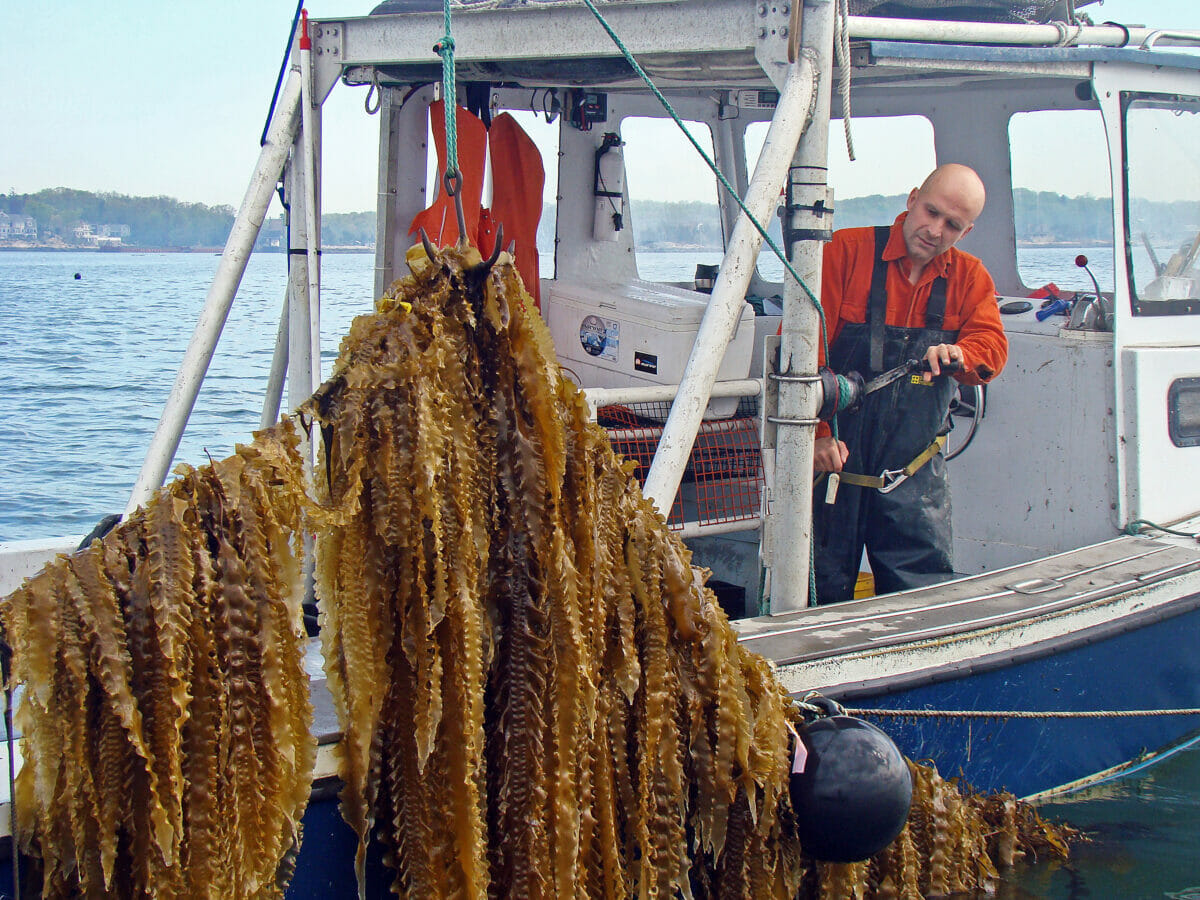Called regenerative ocean farming, this model involves growing shellfish and kelp in underwater gardens.

For all his life, Alaskan fisherman Dune Lankard has looked to the sea—for food, work and purpose. “I started fishing when I was five,” says Lankard, a member of the Athabaskan Eyak community, an Indigenous group from the Copper River Delta. “I really don’t have any skills beyond the ocean.”
Born in 1959, the same year Alaska became a state, Lankard has witnessed various natural and man-made disasters—including the commoditization of Indigenous peoples’ traditional fishing way of life—that have disrupted his industry and homeland. “As an Indigenous fisherman, I’ve seen it all,” he says.
In 1964, a massive magnitude 9.2 earthquake, fittingly called the Great Alaska Earthquake of 1964, triggered a swell of tsunamis that killed more than 130 people and devastated fisheries. Exactly 25 years later, an Exxon Valdez oil tanker struck Bligh Reef in the Prince William Sound, spewing 10.8 million gallons of crude oil into the sea. The spill affected 1,300 miles of water and coastline, much of which is still considered to be in recovery.
Now, Alaskan fishermen are facing another urgent problem. Alaska is already feeling the effects of climate change, as the warming oceans have wreaked havoc on ecosystems of krill, wild kelp forests, salmon and birds. That’s all on top of the lingering losses caused by the 1989 oil spill. Before the Exxon spill, the Sound’s spring run of herring totalled more than 200,000 tons returning home. Today, there are only 4,000 tons returning annually. Lankard recently sold his fishing permit after several consecutive bad seasons.
To help mitigate the effects of warming waters, Lankard is now embracing an approach known as regenerative ocean farming, which involves growing seaweed and shellfish in small underwater gardens. Once a commercial fisherman, Lankard now mostly farms kelp.
“Alaska has always been based on extraction. We’re a natural resource extraction state,” says Lankard. “What regenerative ocean farming does is create a new regenerative economy that’s based on conservation, restoration and mitigation, as opposed to more extraction of resources.”
The burgeoning concept of regenerative ocean farming was developed and named by Bren Smith, a Canadian commercial fisherman turned ocean farmer. He believes ocean farming is the new farming model of the future.
After leaving commercial fishing boats in the Bering Sea in the 1990’s to work on salmon farms, Smith quickly grew disheartened by the farms’ inherent monoculture. Aquaculture was touted as a solution to overfishing, he says, yet was just as destructive.
Disillusioned by the fishing industry, Smith set out to find a more sustainable way to work with the seas. He made his way to Long Island Sound, where there was a program to lease shellfishing grounds to young commercial fishermen under 40. He leased 20 acres of water, where he’s been raising oysters, mussels and kelp on Thimble Island Ocean Farm in Connecticut since 2005. There, Smith worked to hone his sustainable ocean farming model—a journey he chronicled in his James Beard Award-winning memoir, Eat Like a Fish.
“What’s unique about the ocean as an agricultural space? When you stop and ask that question it becomes so easy,” says Smith. “The ocean’s like why don’t you grow things that don’t swim away and don’t have to feed? When you look at the ocean that way, there are hundreds of kinds of shellfish, and thousands of plants we can grow. That opens up a whole frontier of agriculture.”

Bren Smith raises kelp out of the water from a boat. Photo courtesy of GreenWave.
Gradually, Smith transitioned the farm into one of the country’s first 3D ocean farms, which utilizes a vertical water column to grow a variety of species. The polyculture model allows farmers to produce mussels, oysters, clams, scallops and also kelp, which soaks up five times more carbon than land-based plants. And it doesn’t require any irrigation, pesticides or fertilizer. As the farm’s components are stacked vertically, this can all be done with a small underwater footprint.
“There are no pens, no wild fish feed, no antibiotics, which means lower overhead for the farmers,” explains Smith. “You don’t need much structure, and can do it all with scaffolding and ropes and buoys.”
Kelp, which is loaded with potassium, iron, calcium, fiber, iodine and other vitamins, is catching on with chefs and consumers as a tasty, nutritious superfood. It can be harvested and transformed into kelp pickles, kelp mustards, kelp linguine, kelp ice cream and kelp dog treats. But kelp is also used to make non-food products like plant fertilizer that helps reduce nitrogen run-off from land-based farming.
Though Smith initially called his approach 3D ocean farming, he’s recently settled on using the phrase “regenerative ocean farming” to describe it, inspired by “watching out brethren on land,” he says. “We want to create that link between soil and sea.”
In 2014, Smith and Emily Stengel founded GreenWave, a nonprofit organization that helps other ocean farmers replicate the regenerative ocean farming model. “The community of passion is huge, but the community of practice is still quite small,” says Smith. Today, there are around 50 regenerative ocean farmers across the country. GreenWave’s goal is to train 10,000 farmers in the next 10 years. “We have to do 10,000 years of learning in a decade,” Smith adds. “This is our chance to do right and build something powerful and beautiful and just out in the ocean.”
Catherine Puckett, the owner of Block Island Shellfish Farm & Block Island Kelp that’s located 12 miles off the coast of Rhode Island, is one of those new regenerative ocean farmers. Known locally as “Oyster Wench,” Puckett added kelp to her operations in 2018. Before then, she produced only oysters, scallops and quahog clams. “You don’t have to worry about watering it or fertilizing it. It grows in the winter time, so you still have something going on in the off season,” she says. “It’s so worth it.”
In Maine, Matthew Moretti and his father Gary grow mussels and kelp at their farm, Bangs Island Mussels. Growing them together has had a significant impact on the mussels, according to Moretti. “They grow bigger and faster,” he says. And the regenerative ocean farming model has a tremendous impact on the environment. “It’s one of the only local scale solutions that we have for the global scale problem of climate change,” Moretti adds.
Back in Alaska, Lankard is looking forward to involving Indigenous peoples in ocean farming. He now sits on GreenWave’s board of directors, and is the president and founder of the Native Conservancy, where he works with 21 tribes across Alaska to help create a resilient future for their communities.
Kelp farms are a major part of that future, says Lankard, who sees them as an approach “to put the wealth back into our villages.” His own kelp farm has been lucrative enough to allow him the possibility of buying a nearby oyster farm, which he’d convert into a polyculture farming system.
“I’ve had a really good living from the ocean,” he says, “so I feel this is my time to give back to it.”
Beautiful work. One of those, “Why didn’t we think of this sooner?” ideas. Nice.
A lot of potential there.
While I do appreciate the emphasis on no need for pesticides or fertilizers, I do wonder what the quality of these products are as it relates to water pollution and contaminants. Just like a land farmer is concerned about contaminants beyond their control (from neighbors or industry polluting the air, soil, water…), surely there are issues (not highlighted in this article) that need to be acknowledged, studied, and understood. After all, we can consume pollutants through seafood.
Thank you for invate and to send newsletter to me
Very interesting and hopeful
This is our chance to do right and build something powerful and beautiful and just out in the ocean.
How can we help push this to the mainstream? How can we contribute to Greenwave training 10,000 farmers?
People could think of ocean farm as regular farms. There are animal and plants that should be removed to increase the supply of ocean life that serve as human foods. It may be necessary to use “fertilizers” like supplying food to fishes that make them grow faster to increase the production… The problem is that the ocean is to deep adn to wide to be fully controlled. For example, a fish that is not consumed by humans may be harvested so it cannot feed itself of valuable fishs. Their meet could be used to raise river fish. This sort of… Read more »
The future. Very interesting using seaweed as fertilizer.
The whole thing is like, geometric; geometrically interrelated, or like the works of a classic timepiece. Really: how could this have taken this long?